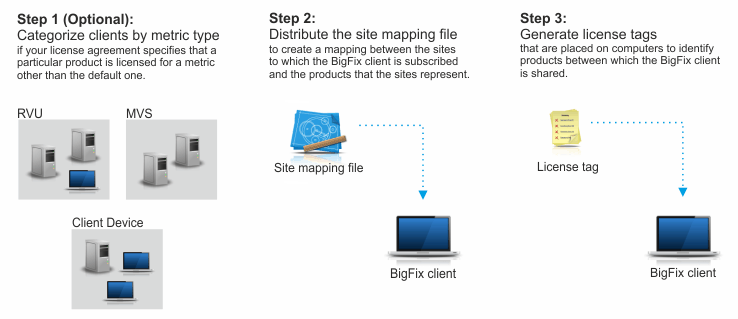Classifying the BigFix client used by multiple BigFix products
BigFix client is a component that is common for all products from the BigFix family. If you have a number of BigFix products installed, the client must be classified as used by these products. Because the client is usually installed on all computers in the enterprise, its manual classification can be time-consuming. To reduce the amount of time and resources that are needed to perform this task, you can generate license tags. The tags mark the client as used by the BigFix products that are installed in your infrastructure. The information is later on reflected in BigFix Inventory without the need of manual classification.
Below is the overview of the procedure. For detailed instructions and troubleshooting information, see: Activating the license counting process.

Step 1: (Optional) Categorize clients by metric type
License metric that is assigned to the BigFix client depends on the operating system on which it is installed. For example, when the client is installed on a computer that runs on Windows 7, it is assigned the Client Device metric. However, when it is installed on a computer that runs on Red Hat Enterprise Linux, it is assigned the RVU MAPC metric. If your license agreement specifies that a particular product is licensed for a metric other than the default one, you can override the default metric.
For example, you might have BigFix Patch, BigFix Compliance and BigFix Protection deployed in your environment. Your license agreement specifies that the first two products are licensed for RVU MAPC but the last product is licensed for the Client Device metric. You can specify that every BigFix client that is used by these three applications is assigned the RVU MAPC metric for BigFix Patch and BigFix Compliance but the Client Device metric for BigFix Protection.
Step 2: Distribute the site mapping file
Create a mapping between the sites to which a BigFix client is subscribed and the products that the sites represent. The information is required to indicate products that use the client. Repeat the step every time you add a product from the BigFix family.
Step 3: Generate license tags
The tags are placed on the computers and contain information about the product name, license metric, and version of the BigFix client. After the software scan, information from the license tag is imported to BigFix Inventory.
Results
After you complete this procedure, wait for the scheduled software scan and the import of data. Then, BigFix client is listed as a component under each BigFix product. The name of the component consists of the product name, license metric, and version of the client.
- BigFix Compliance RVU 9.2 under BigFix Compliance
- BigFix BigFix Inventory RVU 9.2 under BigFix Inventory